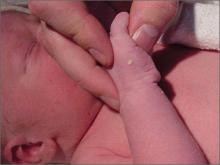The FP diagnosed transient neonatal pustular melanosis in this young patient. To confirm his diagnosis, he sent a photograph from his smartphone to a dermatology colleague, who agreed with the diagnosis.
Transient neonatal pustular melanosis is a disease of newborns with an equal male-to-female ratio. It is seen in 4.4% of black infants and 0.6% of white infants. There is an early, spontaneous remission. This condition is characterized by the presence of 2- to 3-mm macules and pustules on a non-erythematous base at birth. The lesions are thought to evolve prenatally; they subsequently rupture a day or two after birth. They heal as hyperpigmented macules that fade when the child is 3 months of age. Sometimes, the only evidence of the disease is the presence of small, brown macules with a rim of scale at birth.
The FP reassured the parents that the condition was benign and would resolve spontaneously with eventual normalization of any hyperpigmented macules. The child was sent home without any specific treatment.
Photo courtesy of Daniel Stulberg, MD. Text for Photo Rounds Friday courtesy of Richard P. Usatine, MD. This case was adapted from: Shedd A, Usatine R, Chumley H. Pustular diseases of childhood. In: Usatine R, Smith M, Mayeaux EJ, et al, eds. Color Atlas of Family Medicine. 2nd ed. New York, NY: McGraw-Hill; 2013:642-645.
To learn more about the Color Atlas of Family Medicine, see: www.amazon.com/Color-Family-Medicine-Richard-Usatine/dp/0071769641/
You can now get the second edition of the Color Atlas of Family Medicine as an app by clicking on this link: usatinemedia.com


